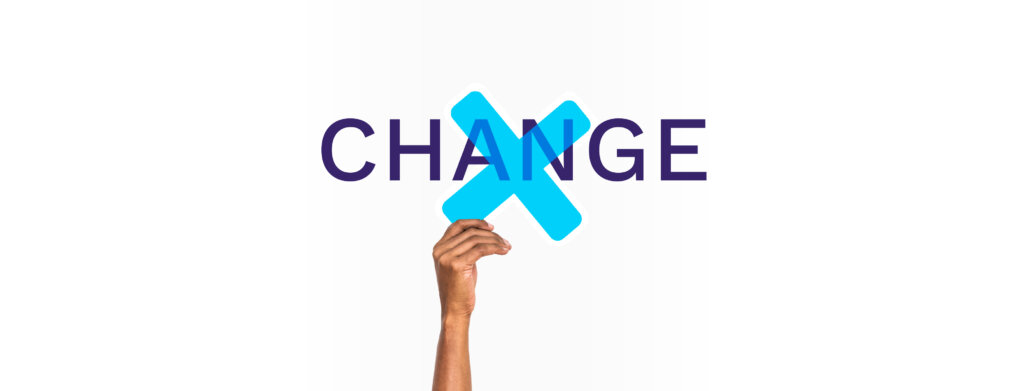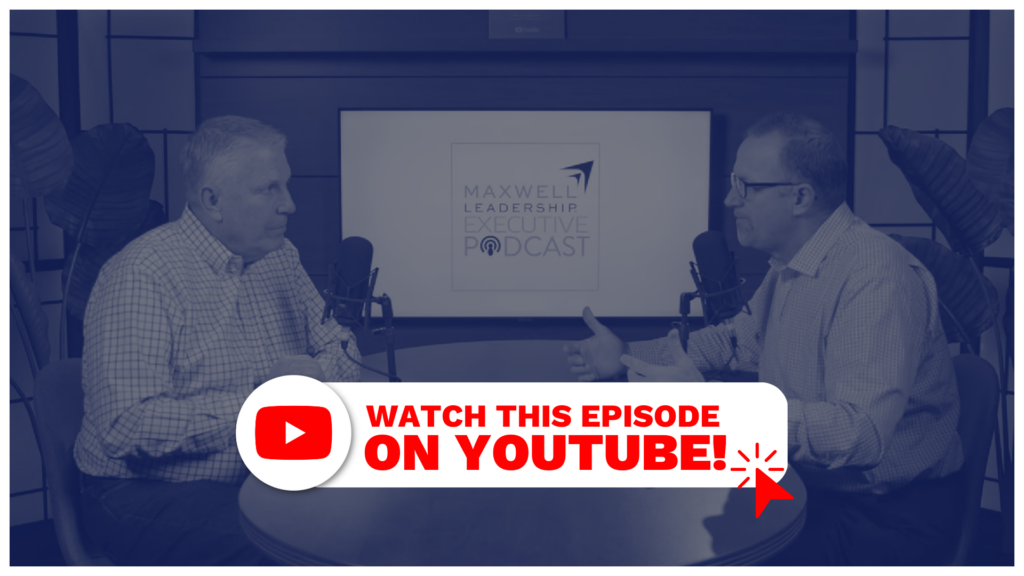Executive Podcast #280: Overcoming Resistance to Change

In this episode, you will discover practical strategies for heading off and reducing resistance to change within your team. By understanding the signs of resistance and uncovering what causes it, you can effectively address the various reasons behind the resistance you encounter. You’ll hear about a powerful concept that offers a new perspective on why people resist change and how to manage the tension that arises during change, all while gaining valuable insights on how to evaluate your own responses to change and adopt a learning mindset to navigate change more effectively.
References:
Become a Maxwell Leadership Certified Team Member!
Register for Day to Grow on March 9th, 2024!
Download our Learning Guide for this podcast!
Perry Holley:
Welcome to the Maxwell Leadership executive podcast, where our goal is to help you increase your reputation as a leader, increase your ability to influence others, and increase your ability to fully engage your team to deliver remarkable results. Hi, I’m Perry Holley, a Maxwell leadership facilitator and coach.
Chris Goede:
And I’m Chris Goede, executive vice president with Maxwell Leadership. Welcome and thank you for joining us today. We are so grateful for our viewers on YouTube, those that are listening. Perry and I were just this morning before recording, got a great text from a friend of ours who we’ve done business with for a long time. Like, man, you guys are literally sitting with me fighting traffic on the way to work and learning. And I love that. And we’re grateful for those that are listening, taking it and applying it and.
Perry Holley:
Using it with their team frustrated with traffic. Listen to us.
Chris Goede:
So basically, if you live in Atlanta, you should have us on repeat, is what we should say. But listen, as we get started, I want to remind you to go to maxwellleadership.com/podcast there. If you’ll click on this podcast, there’ll be a form there that you can submit your information. If you want to learn more about the five levels of leadership, if you want to talk a little bit about, hey, how do I get you guys to talk about this topic that I’m dealing with? Put that on there, and we would love to unpack that for you on an upcoming episode. Well, as you guys know, over the last couple of weeks, we’ve been working through some content on change, which is something that everybody is dealing with. And we’ve been talking about, okay, how do you lead through that? And Perry created some content for us in the second half of last year that we’re now rolling out to some of our clients and some things. And so it’s something that’s becoming more and more of a demand. And so we’ve been unpacking some of the high levels of that.
Chris Goede:
And today’s topic we’re going to talk about, how do you overcome resistance to change? Probably the biggest question, no doubt about it, right? Because we say all the time, people, the first thing they say is, how does this affect me? And all of a sudden, we’re going to talk about that today. They absolutely resist it. And I love this. John Maxwell says, you’re going to get it. You are going to get resistance, so you better expect it. And the key there is, don’t take it personally. And you got to be able to separate that as your leading teams, as you’re leading people, as you’re part of change. And so we’re going to unpack that a little bit today.
Perry Holley:
Yes, human nature a bit. Then I have a theory on that that I picked up through some coaching certifications I received. But, yeah, the idea is, what are the signs of resistance? I always say, is it stompy feet and pouty looks, or is it just bad attitudes, not participating, moving slowly, not taking action, holding back. I mean, you see different things. But I thought today we could approach it from two ways. One, can you head it off and possibly reduce the resistance to change that you are going to get?
Chris Goede:
That’s right.
Perry Holley:
And then the second phase would be, so what do you do when you got it? When you got it. So to do it that way, when.
Chris Goede:
You just said stomping your feet and the pouty face, it reminded me as a parent, which, by the way, when you’re leading teams or you’re part of teams, sometimes you act like a child or have children on team. I just was imagining my kids when they were younger.
Chris Goede:
For those that are not watching Perry cross his arms and little pouty face. And so we used to tell our kids all the know, mind your right, like, we don’t need to know. And there’s other names for people to have facial expressions. We’re not going to go into it on this podcast, but you’re exactly right. As we go through that, you got to think about your body language and minding your face or mind your face. And so I think the first thing a leader should do is understand what is causing that resistance. To your point, it’s going to happen. We’re hopefully going to give you some tips and some things that may help reduce it, but it is going to happen.
Chris Goede:
And so we need to understand what is causing the resistance. And here’s the thing. The resistance in your team members is going to be caused by different things. And so you’ve got to know your people and you’ve got to understand what is going on there because you’re going to have to head off that resistance. It’s not just going to be a resistance. It’s going to be multiple different types of resistance depending on the team member. And so one of the things you put in my notes here to kind of share a couple of questions in regards to this, do they know something you don’t? Right. I started thinking about authenticity.
Chris Goede:
Right. Are you not telling the truth? Do they know more than you do? They’re resisting it because of that. And so you got to uncover that. Do they just not like the direction things are going. We’ve all been a part of that. Or do they simply not like how this change will affect them personally, which is key.
Perry Holley:
It’s going to happen often comes to that. But it does. If you’ve understanding where resistance, what’s affecting, I love your point about it’s very personal. It’s like everybody’s got a set of lenses. They’re looking through their lenses and how they interpret what you’re trying to lead. But also, is it a surprise to them? Did they know anything about this? Did they have a voice in it? Have you spoken to anybody? There’s some tactics we’ve talked about in previous podcasts around how do you communicate? I think communication here is key. If you’re going to have any chance of heading off or reducing resistance, communicating clearly and early what’s coming, a lot of times we don’t have that luxury. You go to a senior meeting when they come back and say, hey, we’ve got a change we’re going to put in place and it’s going to happen immediately.
Perry Holley:
And then you got to deal with the fallout from that. But if you have any Runway, I mean, John actually calls in his plan ahead model, talks about getting way out in front of that. How far out in front can you get of the change to start getting people’s buy in to what’s going on, to do that. But the communication is so important. You want everybody bought in if you can, and that would help reduce it. But again, like you said, everybody’s got their personal view how it’s affecting me, and that’s going to have a lot.
Chris Goede:
To do with it.
John Maxwell:
Hey, John Maxwell here. I’m in the studio. We’ve been recording all day and I was thinking about really one of my very favorite experiences that we have, and that is called day to grow. If you want to grow, you want to grow in every area of your life. I tell people all the time, you don’t want to go to something. You want to grow to something. But if you’re passionate about personal growth, development your team and growing them, you do not want to miss day to grow. I’m going to have some real players with me, Dion Sanders, Jamie Kern, Lima, myself.
John Maxwell:
Oh, my gosh.
John Maxwell:
You don’t want to miss it. So market, come and see us on day to grow. I will promise you this. You come and bring your team. At the end of the day, you’ll come up and shake my hand and say, one of the best days I’ve ever invested in for myself. And for my team. I’ll see you there.
Chris Goede:
Yeah. Often, as leaders, you’re going to be privy to the information before they are. Without a doubt. Sometimes you might not have the opportunity, to your point, get out early ahead of what the change is coming and begin communicating, begin dropping information to them. But if you can, Perry brings up a really good point. If you can, you’ve got to do it early and you got to do it often. I love to think in word pictures. And so what I wrote down here to share is, like, I think about all the time when I’m presented with a change inside the organization, I have no doubt that when I announce this to them personally, their minds are going to begin racing.
Chris Goede:
What does this look like? How does it affect me? And so I’ve got to build a bridge. That’s why I always say to myself, when a curveball comes, when the change is coming down, how do I build a bridge between the change that the senior leadership or the leadership or the organization is calling to the team that I’m leading, that it’s going to directly affect, how do I build that bridge? And so when I think about that and how I communicate that, there’s a couple of things that we want to make sure you understand. Number one, you got to start with the why. They’ve got to understand, you’ve heard Perry and I talk about this before, that people receive information in the why and the how. The people that need to know the how, you can get to that. But when you start with a change, you’ve got to make sure you’re communicating the why, and then you can start talking about how that’s going to affect them personally. There is no doubt that there’s a business reason behind why you’re doing that, what the motives are. And so you have got to build a bridge between what they do on a day to day basis.
Chris Goede:
You should be doing that, by the way, as a leader, period.
Perry Holley:
Right.
Chris Goede:
Without change. But even more importantly now, what they do, the change and how it’s going to affect them and why that is going to help them and the organization in the future. One of the things that you’ve heard Perry say, if you’ve ever been in one of Perry’s trainings or a coaching call, and we’re talking about change, he has this acronym, this thing that he uses, and it’s very catchy because it’s a radio station and he’ll say it’s WiIFM.
Perry Holley:
Everybody’s tuned. Everybody’s tuned.
Chris Goede:
What are you talking about, Perry? I was like, first of all, Perry, no one listens to the FM radio anymore. We’re not teaching a generational diversity course here. We’re talking about change. But then he says, no, it’s really is, and it’s catchy because it helps me remember this, which is what is in it for me. And that’s what you’ve got to really begin thinking about and addressing as you build this bridge to making sure that you’re communicating early and often.
Perry Holley:
I like your word picture of a bridge. I’ve working with Tim Elmore on the generational diversity stuff we talked about. He said it’s bridges and walls, and he said, it’s so easy, anybody can throw up a wall. And so resistance is throwing up a wall. Anybody can do it doesn’t take anything. You throw up a wall. Just you throw it up. A bridge requires engineering and it requires intentionality, and bridges take planning and time.
Perry Holley:
And I thought, yeah, it really grabbed me. I thought, tommy, even making a bridge between somebody that’s resisting change or the team or another generation is that it’s easier for me to book a wall between me and you and let you just deal with it, or take the time to intentionally engineer a wall. Engineer a bridge. What would that take, and how would we build a bridge? I love where you’re going there and then just going back a little bit on that. Involving employees and the team in the change process is it’s really hard to fight against something you have a voice in, and so it’s really hard to resist if you felt like you were heard. And so I just love if you can do anything as a leader when, you know, a change, minor or major, especially if it’s big and going to affect a lot of people, how do I let you have a voice in that? And really getting as many people that are going to be affected as possible to speak to that. I know you do this when we were talking about our different ways we can move forward with something, actually, it generally happens that some process is not working or is causing problem. It’s causing extra work.
Perry Holley:
It’s causing frustration somehow. We said, we need to change that. You don’t just say, change it, and here’s we’re going to try this. Because then everybody said, well, where’d that come from?
Chris Goede:
Right? No.
Perry Holley:
You say, well, what’s possible here? How can we do this here? What do you think? What do you think you should do? How would it affect you? And all of a sudden, people start speaking into it. Then when the decision is made, it’s really hard to say. I hate this. You voted on it.
Chris Goede:
You had a voice. You had a voice. Reminds me of. So that’s the first step, right? It’s like, just get ideas from the team, allow them to speak into it. By the way, as leaders, you may already know the change that’s coming. Doesn’t mean you still don’t need to go about doing this process, because you can take what you’re learning inside that room and report it back up to the leadership team to make it even better. Right? That’s something that we’re really big about. But it reminds me in some training that we do in our 21 laws of leadership, which we were just talking about before we got started, Perry is going to be on the road again next week doing some training with them where you go through an exercise of this or that and you paint two scenarios and you make them choose.
Chris Goede:
And then people get frustrated and they’re like, well, this is a trick question. We’re like, no, you have to pick one and then defend it. So it’s the same thing. Gather information about what they think about the change, what is possible, then create those scenarios. Say, okay, well, if we did this or we did that, now pick one or the other, and then the conversation goes a little bit deeper and then you’ll really have their buy in because they’ve been part of that. You’re not going to always have the time to do that. Sometimes you’re going to have to build a bridge faster than that will allow. But I think that if you could do that to your point and involve them in the change process, it’ll be key.
Chris Goede:
And especially with your influencers on your team, you guys can think about the teams that you’re leading, the people that you do life with, do work with every day. Some of them have more influence than others, and you need to be aware of that. The other thing that we want to talk about is provide incentives and rewards for milestones hit along the way. All right, so let’s go back to this bridge example that we’re running with right now. Someone had to draw plans to that and they knew where there were certain milestones. Go ahead and notate them and let the team know ahead of time. Hey, when we get here, we’re going to celebrate this, celebrate the wins along the way, which will help the whole change process. And by doing that, you’re going to create a little bit of distraction, maybe from your resistors, but also you’re going to help create momentum because you don’t want to underestimate what it’s going to take to make this change, and so allow them to celebrate momentum in the.
Perry Holley:
Way it also keeps you present. I think sometimes leaders, they will go do this and then they go do something else. If you’re paying attention enough to bring an incentive or reward, noting milestones and breaks in the process and how we’re making progress, I think it shows that you’re still present and engaged.
Chris Goede:
I love that. All right, well, let’s talk a minute about what to do when you find yourself in the middle of resistance. Let’s talk about what to do as a leader when that happens.
Perry Holley:
Yeah. I was told, I think most of us been told our whole lives, that people hate change. People fear change. People hate change. And I think I was bought into that. Then I mentioned I got this coaching certification and years and years ago, and my mentor in that, t Falcon Napier, told me the very first thing he said to me, he says, you know, perry, people don’t fear change. They fear losing control. And I thought, okay, that was like radical thinking to me.
Perry Holley:
And he said, and what is change? Change is 100% you being asked to lose control of something you had. And the resistance is that people will do anything and do some wild things to maintain control, not lose control, gain more control. When you say we’re changing, I feel pretty comfortable with what we’re doing. And now you’re saying, now we’re changing, that you have this rush of, how is this going to affect me? And I’m going to lose control. And I just think when you started looking at it that way, that people will do a lot of strange things to stay in control. I thought that started making sense to me. I thought, now I can address things. How can I help you with control?
Chris Goede:
Yeah. Are you saying that we’re all control freaks? Okay. I own that.
Perry Holley:
Right.
Chris Goede:
At some extent, we are some more than others. And so, without change, to your point, I definitely feel in control of my life and my work, but when that happens, I will begin to resist it because I’m not in control. So, this is where, and I’ve heard you talk a lot about this, the tension management is what we really need to do. So let’s talk about this for a few minutes, about managing the tension in the team when you’re feeling that resistance.
Perry Holley:
Yeah. So, the saying that t Falcon taught me was, he said that people pay attention to where their tension is. So when you announce a change process, you announce, we’re going to make a change, large or small, it raises some level of tension. And so what I love about the simplicity of this thinking, it’s simple, but it’s not easy sometimes, is two words that he asked me to think about, especially in coaching. If you’re coaching someone and they’re not taking actions, they’re resisting the direction you’re going. Think about these two words. And the two words are challenge and ability. And so whatever you’re asking them to do, I’m saying, chris, I want you to do this completely new process.
Perry Holley:
I know you’ve been doing it the other way, but we’re going to change how we do it. I need got these other checkpoints and you go, how’s that affecting? I’m feeling like I’m losing control. You say, well, why would we? Do you start to press back, you’re going to resist me. I would say, okay, with the two words. What are the two words? Challenge and ability. What is Chris’s perceived ability to do what I’m asking him to do, high or low? What is Chris’s perceived challenge of doing what I’m asking him to do, high or low? And then you begin to kind of say, if you have a lot of ability and it’s no challenge, I might hear Chris say, why would I change? Everything’s just fine. And I’m saying, no, that status quo is not fine. We need to change.
Perry Holley:
But you might even be apathetic about it, or you have mastery. You are so good at what you do that there’s no challenge to you in it anymore. But then I thought, well, what if I could raise? We started to think, how can we affect that? But what if you say, what I’m asking you to do has a lot of challenge and you have no ability? That’s a whole different place on the scale that says, now you could be freaking out thinking, oh, my gosh, how am I going to do this? I have no ability, and the challenge is high to do that. So when I started putting these frames that everybody pays attention to where their tension is, can I figure out where their tension is based on these two words, challenge and ability?
Chris Goede:
I remember one of our first ever coaching conversations that you and I had. You used this illustration of your son mowing the yard.
Perry Holley:
Yes.
Chris Goede:
Right. Just to flesh it out a little bit more. Just share, like, even that concept, the principles that you just talked about, share that in the concept of mowing the yard and how you use that when you were leading and influencing your son.
Perry Holley:
Oh, yeah. I said, I like to see the grass cut before I get home from work today. I come home from work I come home from work and the grass is not cut. And I say, son, why is the grass not cut? He said, I didn’t have time. I said, well, could you give me just a short synopsis of your time today? Well, I got a plate, went to the mall with my buddy, got a new video game, came home, played, oh, my way with all two girls at the mall. We hadn’t sitting at a coke and got late. And then we got home. We want to play the video game.
Perry Holley:
The sun went down. You can’t cut the grass in the dark. As you can see. I didn’t have time. A lot of people would say, you have a discipline problem. Because I’m a trained professional. You as your dad, I know that I have a tension management problem. You’ve seen my son.
Perry Holley:
He’s a big, strapping guy, and my yard is small and flat. I said, what do you think the challenge of cutting my grass is for this boy? Zero low. What do you think the ability he has? Cut my grass high. Okay. He’s in apathy. He’s mastered it. What you hear him say is, he knows the grass needs to be cut, but he’ll say something like, I know the grass needs to be cut. I hope my sister does it, because he’s going to do something.
Perry Holley:
He has no tension around this. So the question is, how do I raise his tension to do that? And so that’s kind of the lesson here, is are there some strategies for raising tension and lowering tension to do that? So how would you raise tension? What word would you mess with of the two words, challenge and ability? If I want to raise your attention, you have too low attention, so you have a lot of ability. Low challenge. What would you mess with?
Chris Goede:
I would mess with the challenge, yes. Right. And so I would change the challenge for your son, whatever that might be, to lay it down in order, because the ability is there. Right. And where the apathy is coming from is he’s not challenged to do it. And at the point in time, he was a teenage boy and was highly distracted.
Perry Holley:
Yeah, you’re exactly the right thing. So with raising it, you’re kind of thinking about increase the standard I’m asking for. So I might say instead of just having the grass cut before I get home, I’d like the grass cut by 10:00 a.m. Eastern daylight time. You got to be specific with these children. There’s two tens on the clock, and I don’t know if he’s going to. I want 10:00 a.m.. Eastern daylight time.
Perry Holley:
On that you might change the task. I’d like to not only have the grass cut, but I’d like you to send me pictures of said cut grass to my intelligence phone there. I want to see pictures of it done. And then you might say boost in accountability. By the way, if I don’t get pictures by 1015 Eastern daylight time, I will take away your Xbox. You’ll never play Xbox in my house again. So what do you think happened? Phone blows up at like 930 way early and great pictures. I think he had a ladder.
Perry Holley:
Showed me the totality of the cut he got down on.
Chris Goede:
Probably cross ground level.
Perry Holley:
Yeah. Showed me the quality of the cut with a ground level view. He showed me the trimming and the blowing of the. I didn’t even ask for trimming and blowing, but I got extra because I was able to raise his level of tension around increasing the challenge. So what happens, though, if you have somebody that you announce a change, they’re freaking out. Oh, my gosh. I have no ability. The challenge is really high.
Perry Holley:
I don’t know what to do. I don’t know what to do. You might even hear them say, just tell me what to do. I don’t know what to do. And then they’re not really bought in. Can you bring tension down? So how would you bring tension? What word would you mess with there?
Chris Goede:
The ability. And for us, we talk a lot about the difference between training and developing. And in certain situations it may take some training.
Perry Holley:
Yes.
Chris Goede:
Right. More than it will take developing. Although going through that process with them and even this tension management you’re talking about here will develop them, by the way, as a leader, as an individual, as a contributor to your team. But it’s going to take some training for them to increase their ability. Yeah.
Perry Holley:
And you can actually mess with both words when you’re trying to lower tension because I definitely agree with you need to raise their ability. That could be training, coaching, mentoring. I could bring people alongside of you to help with your ability, but I can also mess with challenge. How do I bring it down? Sometimes people just need to know. Normalize to say everybody, you’re not the only person. This is affecting all of us. We’re in it together. So normalize it.
Perry Holley:
I might also simplify the task. I know this looks like a big, hairy, audacious change, but let’s just focus on this one thing now and then we’ll do the next thing and do the next thing. So a lot of people look at, it’s just so big, so much too much that they freak. And you think, what if I bring the challenge down, the ability up? Can I get you to a threshold of activation where you’ll actually take action? And that’s the goal, is I want you to take action on the changes we’re doing, either personal in a coaching context, which is how I use it a lot, or as a team. As people are freaking out, I need to just pay attention to tension because that’s how they’re going to react.
Chris Goede:
To do that, that is a ton of value right there for you leaders that are maybe getting resistance for change, or when you do get it, think about those two words that we just unpacked for you about the ability and the challenge and evaluate. We started off the conversation today by saying, you’re going to have to lead people differently through change. They’re going to resist it for different reasons. Perry just really kind of laid out a roadmap for you to really unpack where it is that they’re struggling and you’re going to have to balance and manage that tension. So as we wrap up, one of the things I was thinking about is, well, what if I’m on the other side of the resistance, right? What if I’m a team member listening right now, or by the way, as an executive, I still have resistance to change. All of us do, because things are always changing. I wrote down just a couple of questions for you to evaluate what’s going on and figure out, how do I get past this? How do I become better at not resisting change so much? The first one, ask yourself, what are you resisting? Not why, but what are you resisting? Be specific and be honest, and then just focus on what you can control. I think that’s really key.
Chris Goede:
Second one was to our point about losing control. Are you just you fearful of losing control? And what’s the worst case scenario if you do lose control? The third one was adopt a learning mindset. One of our values here is that we are adamant about growth. Well, growth comes in multiple different ways. It comes from listening to audible. It comes from reading books. It comes from listening to our podcast. It also comes from experience, hopefully.
Chris Goede:
Yeah.
Chris Goede:
It also comes from experiences. So understand that you’re going to learn some things and have a learning mindset through change. And then finally ask yourself this question, what would I do if I wanted this change to work?
Perry Holley:
Oh, that’s good, right?
Chris Goede:
Because you go, I’m not doing this. But if you sat back and you said, okay, if I wanted this change to work, what would I do? You’d be amazed at where your mind goes and some of the ideas that will come about how it can change your perception and your reaction to change.
Perry Holley:
I love it. Well, great stuff. And if you want to know more about, there’s a learner guide for this. Also, you can learn about our offerings. You can learn about our other parts of our podcast family that are available. You can do all that at maxwellleadership.com/podcast. You can also leave us a question or a comment there.
Perry Holley:
We love hearing from you, and we’re very grateful you’d spend this time with us today. That’s all today from the Maxwell Leadership executive podcast.
To be a Successful Leader, You Need Feedback on Your Leadership.
We’re excited to announce our new and improved Organizational Effectiveness Survey (OES). The OES gathers feedback from employees to give leaders and management the knowledge and action plans needed to develop a more effective and productive work environment. Our new version measures 4 areas of your business: Leadership, People, Strategy, and Performance.













Be the first to comment on "Executive Podcast #280: Overcoming Resistance to Change"